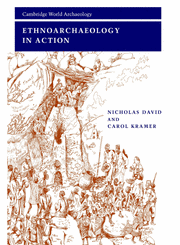Book contents
- Frontmatter
- Dedication
- Contents
- List of figures and credits
- List of tables
- Preface
- Acknowledgments
- Map
- 1 Ethnoarchaeology: its nature, origins, and history
- 2 Theorizing ethnoarchaeology and analogy
- 3 Fieldwork and ethics
- 4 Human residues: entering the archaeological context
- 5 Fauna and subsistence
- 6 Studying artifacts: functions, operating sequences, taxonomy
- 7 Style and the marking of boundaries: contrasting regional studies
- 8 Settlement: systems and patterns
- 9 Site structures and activities
- 10 Architecture
- 11 Specialist craft production and apprenticeship
- 12 Trade and exchange
- 13 Mortuary practices, status, ideology, and systems of thought
- 14 Conclusions: ethnoarchaeology in context
- Bibliography
- Index
9 - Site structures and activities
Published online by Cambridge University Press: 05 March 2015
- Frontmatter
- Dedication
- Contents
- List of figures and credits
- List of tables
- Preface
- Acknowledgments
- Map
- 1 Ethnoarchaeology: its nature, origins, and history
- 2 Theorizing ethnoarchaeology and analogy
- 3 Fieldwork and ethics
- 4 Human residues: entering the archaeological context
- 5 Fauna and subsistence
- 6 Studying artifacts: functions, operating sequences, taxonomy
- 7 Style and the marking of boundaries: contrasting regional studies
- 8 Settlement: systems and patterns
- 9 Site structures and activities
- 10 Architecture
- 11 Specialist craft production and apprenticeship
- 12 Trade and exchange
- 13 Mortuary practices, status, ideology, and systems of thought
- 14 Conclusions: ethnoarchaeology in context
- Bibliography
- Index
Summary
Analyses and interpretations of [site structure] patterns have until lately been based on three assumptions: (1) that activities are spatially segregated …; (2) that activities typically produce characteristic co-variant sets of artifacts and other refuse in proportion to the frequency of performance; and (3) that artifacts and other refuse associated with a particular activity are deposited at or very near the place of performance.
(James O'Connell 1987: 74)There can be no general theory and no universal method for measuring and interpreting activity residues … we cannot look to ethnoarchaeology to provide the answers.
(Ian Hodder 1987a: 424)In this chapter we discuss living space and activity areas of peoples, focusing especially on hunter-gatherers and others who do not produce substantial built structures. When approached archaeologically, such situations require that both the living context of the remains be inferred and the activities that took place within and around it. Where there are architectural remains (see chapter 10), artifacts and other debris can be directly related to structures and the spaces between and around them. We begin by sampling the ethnoarchaeological literature on the site structure of hunter-gatherers, the latter term requiring somewhat liberal interpretation, and proceed to survey evidence relating to peoples practicing other subsistence strategies. The chapter ends, rather than concluding, with discussion of studies that consider the extent to which gender is associated with activities, and whether these are likely to be archaeologically identifiable.
- Type
- Chapter
- Information
- Ethnoarchaeology in Action , pp. 255 - 283Publisher: Cambridge University PressPrint publication year: 2001



